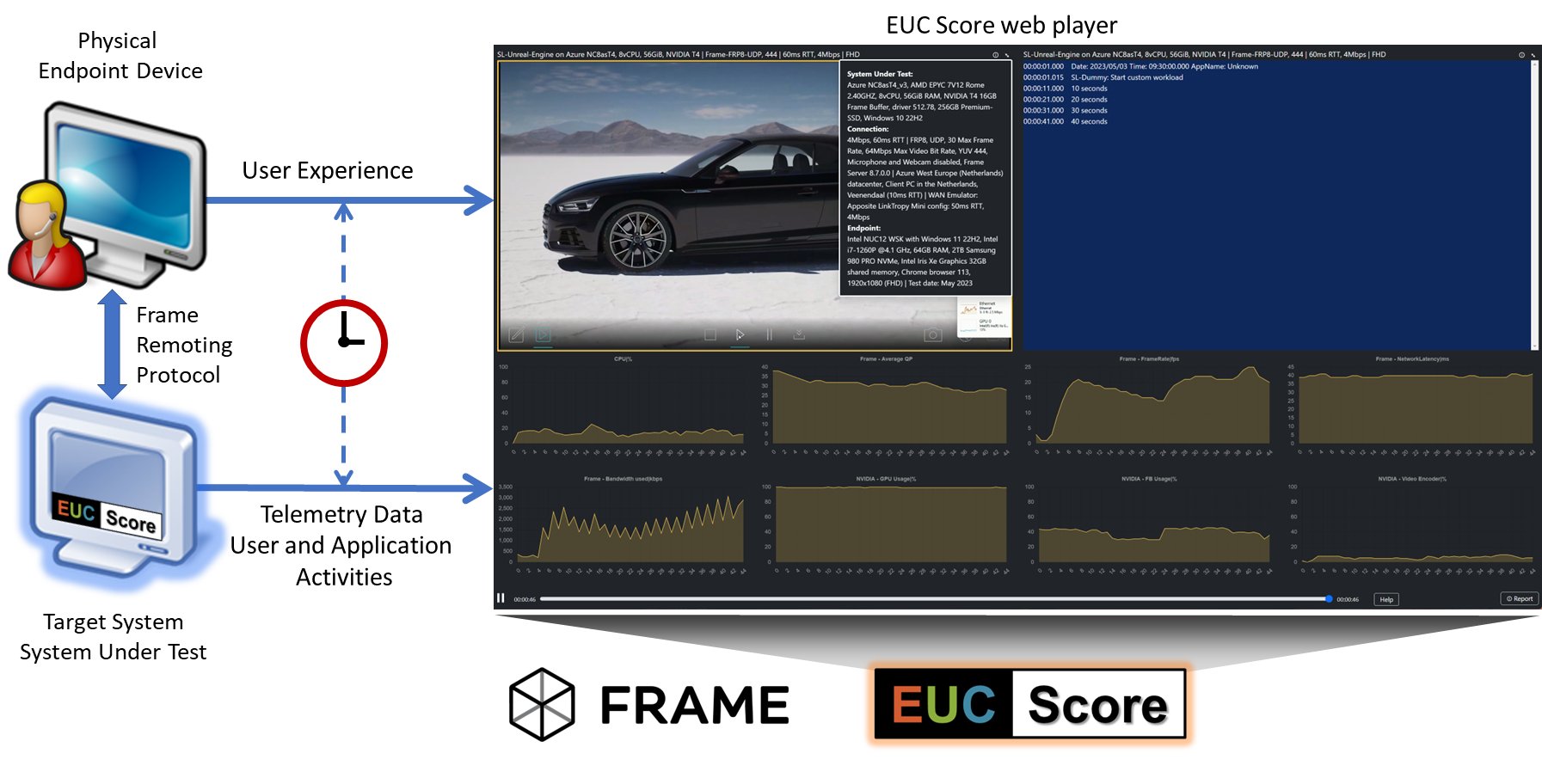Resources
Dizzion uses an outstanding benchmarking methodology and performance measuring toolset called EUC Score. This toolset focuses on the actual visual experience perceived by remote users on their endpoint screens while simultaneously measuring relevant metrics generated on the host platform. The results are provided in EUC Score's web player which displays the visual user experience along with factual system metrics and telemetry data.
Why EUC Score?
EUC Score is not only a specialized solution, but an advanced methodology designed to capture, measure, and quantify the perceived end-user experience in Desktops/Applications as a Service, and VDI environments. By recording high quality videos of real user experiences on client devices accessing e.g., Frame-powered virtual desktops or applications, EUC Score provides a comprehensive understanding of the user's perspective. Furthermore, it combines this video data with a range of telemetry information, such as memory, GPU/ CPU utilization, Frame Remoting Protocol (FRP) statistics, network insights (bandwidth, network latency, compression applied to the video stream), and more.
The EUC Score web player offers a consolidated, easily consumable view which brings together the captured user experience video and telemetry data. Equipped with this information, customers and partners gain a deeper understanding of how the remoting protocol, different virtual machines (VMs), various endpoint devices, and network conditions impact end-user experience. This knowledge allows them to appropriately size and configure their resources. Additionally, in cases where users report issues with their experience, the EUC Score helps identify the root cause. This way, instead of merely assigning a more powerful VM, potential network-related problems or limitations of the remoting protocol can be addressed to deliver the best user experience.
While most vendors and partners focus on benchmarking virtual machine instances (which is helpful in assessing the relative performance of VMs and various applications running within the VM), they often overlook the crucial factors influencing user experience between the datacenter and the end user. The Frame Remoting Protocol, its ability to provide a superior user experience under diverse network conditions, and the specific network characteristics like bandwidth, latency, and packet loss can all significantly impact the overall user experience.
What are the basic requirements to run User Experience EUC Score experiments?
Target System: a physical PC or Virtual Machine (VM) running a Windows operating system and Windows applications should serve as the target system and be configured to allow remote connections. Virtual Machines managed and accessed by Frame can run on public cloud with Azure, AWS, GCP and on-premises with Nutanix AHV.
Physical Endpoint Device: a physical endpoint device with the necessary remoting software or just a browser installed, enabling remote desktop connections to the target system. With regards to endpoint device type, this can be any device. Some examples would be:
- an Intel NUC running Windows 11 using Chrome to initiate a Frame session
- thin clients like IGEL, Unicon, Stratodesk, 10Zig, Apple Mac, or Google Chromebooks.
The endpoint device is used to start a remote session, and its HDMI output is connected to the hardware video capture device.
Video Capture and Recording: A video capture device is a hardware device that connects to a computer that converts the video signal from the output of an physical endpoint device into a digital video feed that a recorder computer can use. Set up a screen video capture device and a PC with OBS Studio installed to record the experiments. While basic video capture can be achieved using software solutions, for high-quality and accurate on-screen recordings, a dedicated capture device is recommended such as AVerMedia Live Gamer 4K Capture Card GC573, Epiphan DVI2PCIe or DVI2USB or Elgato Game Capture HD60 S. Using a video capture device is crucial for recording Simload screen videos and is considered an essential element for benchmarking perceived remote user experience. The video stream produced by the capture device serves as the input signal for video recording software like OBS Studio.
EUC score software: The EUC Score Base software package, EUC Score Enterprise software package, and Sync Player package provide the SimLoads, telemetry collection and the tools to create a EUC Score web player. A Simload, which is a simulated workload, mimics user activities within the application. The Simload opens one or more applications, starts logging time-stamped events and information, simulates user interactions by controlling the applications, and after a predetermined time terminates all applications under control and stops logging telemetry data. The EUC Score Player is an HTML5 data visualization and analytics tool used for the visual representation and timely correlated animation of individual EUC Score benchmark datasets.
Windows application: Download, install, and configure the Windows applications you want to use with the SimLoads.
Network: Remote access to a target system a stable, managed, and controlled network connection with a minimum speed of 100Mbps is required between the endpoint PC and the remote session.
Network emulation: WAN emulation devices such as the Apposite Linktropy Mini2 simulate different network conditions. They imitate factors like available bandwidth, network latency (round-trip time), and packet loss. Essentially, the network emulator functions like a real network. You can connect Physical Endpoint Device to the emulator, and they will behave as if they are connected to an actual network.
